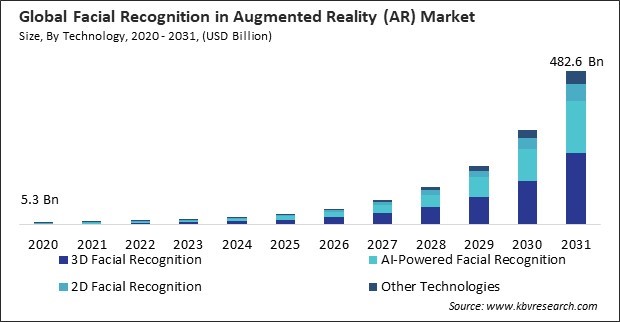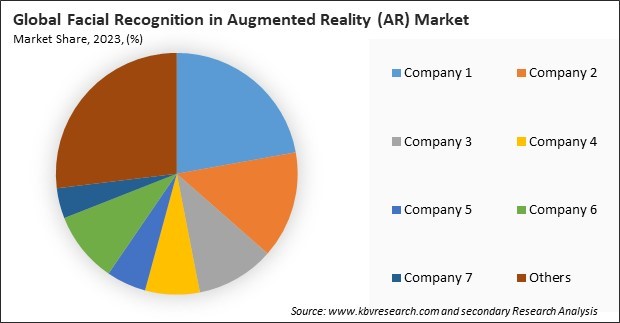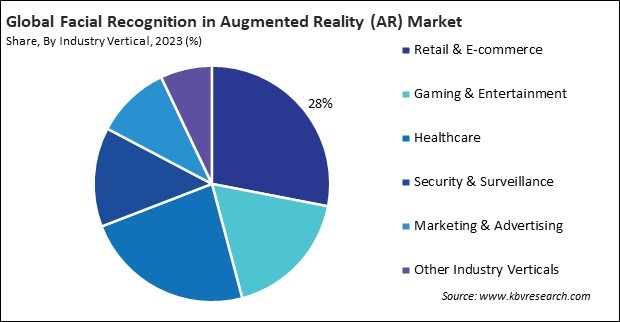“Global Facial Recognition in Augmented Reality (AR) Market to reach a market value of USD 482.6 Billion by 2031 growing at a CAGR of 53.1%”
The Global Facial Recognition in Augmented Reality (AR) Market size is expected to reach $482.6 billion by 2031, rising at a market growth of 53.1% CAGR during the forecast period.
Integrating facial recognition technology with AR in security and surveillance applications has significantly enhanced the ability to monitor and identify individuals in real time. This technology is widely adopted by law enforcement agencies, airports, and commercial establishments for its ability to provide accurate and immediate identification, thereby improving security measures and response times. Therefore, the security & surveillance segment attained 14% revenue share in the market in 2023. The increasing demand for advanced surveillance solutions in both public and private sectors has driven the growth of this segment, ensuring its leading position in the market.

The evolution of smart surveillance systems that combine multiple technologies, including cameras, sensors, and AI, fosters facial recognition capabilities' integration. AR technologies can overlay data and information in real-time, providing operators with contextual insights that enhance situational awareness during security operations. Facial recognition within AR frameworks provides a robust solution to identify individuals, track behaviour, and prevent unauthorized access in public and private settings. Additionally, the digital transformation wave has led to significant advancements in artificial intelligence (AI) and machine learning technologies, which are crucial for developing sophisticated facial recognition algorithms. These improvements enable AR applications to accurately identify and analyze facial features, emotions, and expressions, enhancing user engagement and experience. This capability is particularly important in applications such as virtual meetings, where facial recognition can help create more immersive environments.
However, beyond initial implementation, ongoing maintenance and support for facial recognition systems can add to the financial burden. Regular software updates, technical support, and system monitoring require resources that may strain the budgets of SMEs, making the technology less attractive for smaller organizations. Effective use of facial recognition technologies in AR often requires specialized staff training. SMEs may need to allocate funds for training programs to ensure that employees can operate and maintain these systems effectively, adding to the overall implementation costs. Therefore, SMEs' high implementation costs and financial barriers hamper the market's growth.

The leading players in the market are competing with diverse innovative offerings to remain competitive in the market. The above illustration shows the percentage of revenue shared by some of the leading companies in the market. The leading players of the market are adopting various strategies in order to cater demand coming from the different industries. The key developmental strategies in the market are Acquisitions, and Partnerships & Collaborations.
Based on end user, the market is categorized into enterprises, public sector, individual consumers, and others. The individual consumers segment witnessed 22% revenue share in the market in 2023. This growth is attributed to the rising adoption of AR applications and devices among consumers for entertainment, social media, and personal security. Facial recognition technology in AR enhances user experiences in gaming, social networking, and photography by enabling features such as personalized avatars, filters, and secure access to personal devices. The increasing availability of affordable AR-enabled smartphones and tablets has made facial recognition technology accessible to a broader consumer base, contributing significantly to this segment's revenue.
Based on industry vertical, the market is divided into retail & e-commerce, healthcare, gaming & entertainment, security & surveillance, marketing & advertising, and others. In 2023, the retail & e-commerce segment procured 28% revenue share in the facial recognition in augmented reality (AR) market. Retailers and e-commerce platforms leverage facial recognition and AR to enhance the customer shopping experience through personalized recommendations, virtual try-ons, and targeted marketing. This technology helps analyze consumer preferences and behaviour, allowing retailers to offer customized solutions and improve customer engagement.

Based on technology, the market is divided into 3D Facial Recognition, AI-Powered Facial Recognition, 2D Facial Recognition, and Others. The AI-powered facial recognition segment attained 33% in the market in 2023. This segment’s growth is fuelled by the increasing integration of artificial intelligence with facial recognition technologies, which enhances the accuracy and efficiency of identifying and verifying individuals. AI-powered systems can quickly analyze vast amounts of data, learning and improving from each interaction. This adaptability makes AI-powered facial recognition ideal for dynamic environments and applications such as personalized marketing, user authentication in consumer electronics, and public safety.
By device type, the market is divided into smartphones & tablets, AR headsets & glasses, kiosks & interactive displays, and others. In 2023, the smartphones & tablets segment registered 54% revenue share in the market. The widespread adoption of smartphones and tablets with advanced facial recognition capabilities has driven this segment’s growth. These devices offer convenience and accessibility, making facial recognition technology easily available to a large user base.
Free Valuable Insights: Global Facial Recognition in Augmented Reality (AR) Market size to reach USD 482.6 Billion by 2031
Region-wise, the market is analyzed across North America, Europe, Asia Pacific, and LAMEA. The North America region witnessed 38% revenue share in the market in 2023. This can be attributed to the high adoption rate of advanced technologies across various retail, healthcare, and security industries, including facial recognition and augmented reality. The presence of major technology companies and extensive research and development activities in the region have further propelled the market growth.
| Report Attribute | Details |
|---|---|
| Market size value in 2023 | USD 17.7 Billion |
| Market size forecast in 2031 | USD 482.6 Billion |
| Base Year | 2023 |
| Historical Period | 2020 to 2022 |
| Forecast Period | 2024 to 2031 |
| Revenue Growth Rate | CAGR of 53.1% from 2024 to 2031 |
| Number of Pages | 362 |
| Number of Tables | 500 |
| Report coverage | Market Trends, Revenue Estimation and Forecast, Segmentation Analysis, Regional and Country Breakdown, Market Share Analysis, Porter’s 5 Forces Analysis, Company Profiling, Companies Strategic Developments, SWOT Analysis, Winning Imperatives |
| Segments covered | Technology, Device Type, Industry Vertical, End User, Region |
| Country scope |
|
| Companies Included | Blippar Group Limited, Apple, Inc., Clarifai, Inc., Cognitec Systems GmbH (Salto Systems, S.L.), Meta Platforms, Inc., Google LLC, Qualcomm Incorporated (Qualcomm Technologies, Inc.), Amazon Web Services, Inc. (Amazon.com, Inc.), Microsoft Corporation, Zebra Technologies Corporation |
By Technology
By Device Type
By End User
By Industry Vertical
By Geography
The Market size is projected to reach USD 482.6 billion by 2031.
Rising Demand for Enhanced Security and Surveillance Systems are driving the Market in coming years, however, High Implementation Costs and Financial Barriers for SMEs restraints the growth of the Market.
Blippar Group Limited, Apple, Inc., Clarifai, Inc., Cognitec Systems GmbH (Salto Systems, S.L.), Meta Platforms, Inc., Google LLC, Qualcomm Incorporated (Qualcomm Technologies, Inc.), Amazon Web Services, Inc. (Amazon.com, Inc.), Microsoft Corporation, Zebra Technologies Corporation
The expected CAGR of this Market is 53.1% from 2024 to 2031.
The 3D Facial Recognition segment is leading the Market by Technology in 2023; thereby, achieving a market value of $226 billion by 2031.
The North America region dominated the Market by Region in 2023; thereby, achieving a market value of $172 billion by 2031.
Our team of dedicated experts can provide you with attractive expansion opportunities for your business.

 Drivers
Drivers
 Restraints
Restraints
 Opportunities
Opportunities
 Challenges
Challenges
